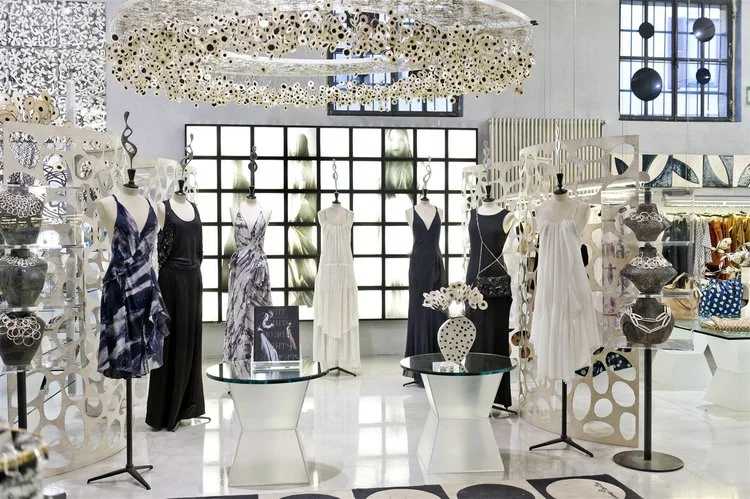10 Corso Como Milan / Photo: theitalianeye.com
Walking into a Nordstrom in NYC, it’s almost guaranteed that you’re greeted with a bulging stand of Topshop crop tops and at least several perfume salespeople before finding the shoe section and cosmetics counters. While this consistency makes for a familiar in-and-out on your way to grabbing a refill of waterproof Le Volume de Chanel, it can also be seen as predictable and rather oppressive. Coupled with the hassle of lines, the lingering scents of tested perfume, and the trouble it can take to get an Uber, it’s not surprising that digital is becoming the shopping platform of choice for an ever growing number of consumers. After all, the right vendor could have that mascara shipped to you within the hour.
These numbers have many industry analysts doubting physical storefronts, in much the same way that publishers gawked and predicted the demise of print. Department stores in particular have faced increasing difficulty attracting customers to their brick-and-mortar locations, with many shutting stores or trying to come up with ways to implement digital technology to better engage shoppers.
Defined by a love of personalization and a seamless shopping experience, today’s “shrewder shopper” (coined by the BoF report) loves consistency, but loathes predictability. Rather, he or she craves a milieu of ‘tions ‘ innovation, customization, and interaction among them. Traditional brick-and-mortar storefronts, namely luxury department stores, struggle to give these shoppers the authentic, shareable, and worthwhile experience they crave.
For the most part, department stores and other on-the-ground retailers provide a consistent, curated environment for shoppers to weigh their options, test them, and take advantage of personal customer service (if the store is doing it right). The reliability of knowing when and where the new Gucci collection will be in her local Saks and the ability to try before she buys — or in this case, invests — will keep a shopper commuting to the storefront. But, given she might know her size and not have the time, she could also stay home and order it online.
Rachel Schectman, founder of the Manhattan concept store Story, knows customers need an incentive to leave the convenience of online behind. “If time is the ultimate luxury and people want a higher return on investment of their time, you need to give them a reason to be in a physical space,” she says, as told to BoF.
Dover Street Market London / Photo: timeout.com
Dover Street Market has a similar setup to Story, in that the merchandise and store displays are overhauled every January and July. Each designer who collaborates with Rei Kawakubo’s seven-story space has total creative control, save for a general rule to spend as little as possible. So when the aforementioned Gucci shopper takes the time out of her day to go to DSM, she’s stepping into a section entirely designed by Alessandro Michele and immersing herself a little further into the collection. She gets to buy this season’s loafers and experience them, too.
This immersion and engagement with a brand, as aptly pointed out by Carmen, is vital to the customer care experience and success of growing retail brands. “As humans we need experiences in order to create an emotional link with belongings,” she says. “The question of how to bring the offline experience online is an interesting one and many people like Dover Street Market, Corso Como, Colette, Maxfield, Maria Luisa, Brown’s and Moda Operandi have always known this, and this is the secret of their success.”
More than ever, a retailer longing for a lucrative brick-and-mortar location needs to create a worthwhile experience for the consumer by elevating amenities, holding exclusive events, and integrating technology into changing rooms. It’s not enough to have the products – online almost always has more selection. Providing a service and setting a tone, whether it be a glass of champagne upon arrival, a pre-sale for VIPs customers, or adjustable lighting that lets you see yourself in something more flattering than fluorescent, can ultimately heighten the customer experience. Concept stores and those with high visual turnover take it one step further and create demand by constantly changing their offering and presenting it in an almost immersive way.
Digital, while it poses a threat, can make brick-and mortar smarter, more appealing. If on-the-ground luxury stores are going to survive the eclipsing presence of e-commerce, they can’t follow their current formats. E-tailers experimenting in brick- and-mortar, or those simply wanting to connect more with their core customer, can use data from online to improve their physical storefronts and giving shoppers exactly what they’re looking for. If done right, a great physical presence can fuel online sales as it reinforces the relationship between the consumer and brand. Much like an old friend you need to meet face-to-face for dinner once in a while, even if you text every day. So, while digital is to print as e-commerce is to traditional retail, online can’t be seen as the enemy, but as a tool to better market stores to consumers and create a retail experience worth leaving the house for.
Lauren Santo Domingo with Giambattista Valli / Photo: vogue.it
One such event had M’O customers sitting in on a talk with Giambattista Valli. Knowing full well a glass of champagne wouldn’t be enough to get her busy customers to come in on a Wednesday night, LSD played host to the designer in conversation with herself and fashion journalist Gianluca Longo. Customers listened to the designer recount how he fell in love with couture, before purchasing pieces from his latest collection.
Not every retailer can afford to bring shoppers face-to-face with a famed couturier, but they can adjust their in-store strategy. Most consumers appreciate e-commerce because it affords them the ultimate luxury – more time. If brick-and-mortar retailers want consumers to keep coming in instead of clicking-to-buy, they’ll need to take note and get creative, so that time spent in store is seen as an experience worth savouring.




